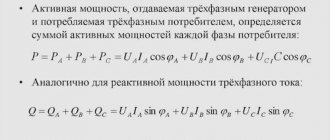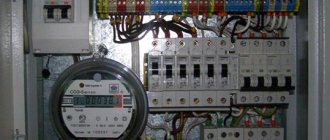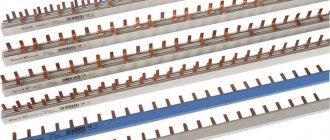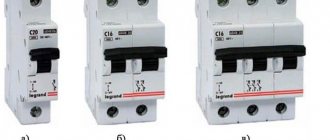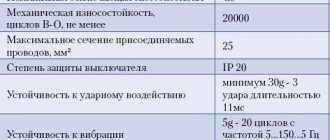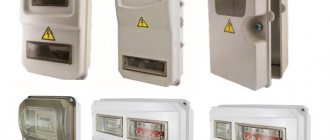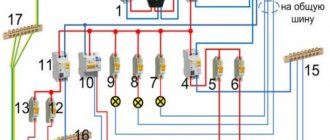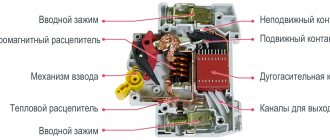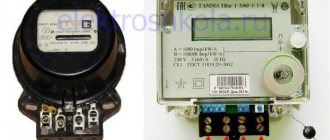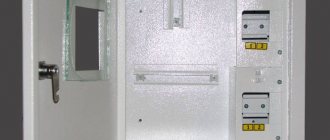5 / 5 ( 2 voices)
ABB circuit breakers , or ABB circuit breakers for short, are what we will be talking about in this article. ABB circuit breakers, which are used in electrical panels of apartments or private houses, are divided into two series. The first series is the “stripped-down” budget SH 200 and the second, more sophisticated series of ABB S200 automatic machines. In my electrical panels, I use ABB S200 circuit breakers , which have a number of advantages over the budget ABB SH200 circuit breakers. After all, you must admit that in order to make a budget version of any product, you need to remove something, cut down, save on something, and so do the ABB SH200 automatic machines.
Instagram https://instagram.com/elektroschyt VKontakte https://vk.com/elektrika46
When choosing a quality machine,
the main criterion is a well-known brand and purchase from official dealers .
When assembling electrical panels, I buy components from E, which are official representatives of ABB and Schneider Electric in Russia. ABB circuit breakers are switching devices
which disconnect and switch off the power to cable lines, ABB circuit breakers protect cables from short circuit currents and overloads (currents higher than the rated currents of ABB circuit breakers). Or, to put it briefly, ABB circuit breakers protect against overcurrents.
circuit breakers disconnect currents up to 6 kA , ABB SH200 circuit breakers up to 4.5 kA, i.e. These are the currents that ABB circuit breakers can switch off without causing a fire. Short circuit currents are calculated based on the load; in everyday life they do not exceed 6 kA, and therefore there is no need to install ABB circuit breakers with higher maximum current values in the panel of an apartment or private house.
Description of single-pole switches ABB S201 C
Modular single-pole switches ABB S201 C are designed to protect electrical circuits from overloads and short circuits in cable lines, electric motors, lighting systems, and socket lines. They have two different trip mechanisms: a delayed thermal trip mechanism for overload protection and an electromechanical trip mechanism for short circuit protection.
Circuit breaker device
The body material of the S201 C is made from the most advanced materials, consisting of the latest generation of thermoplastics, which do not contain halogen pollutants and are recyclable.
All circuit breakers are equipped with contact position indication (CPI). You can easily determine whether the circuit breaker is in the on position, which makes maintenance work easier and safer.
How to choose a machine
ABB circuit breakers, used in apartments and country houses, are produced by industry in two types - ABB SH200 and ABB S200
The industry produces single-pole, double-pole, three-pole and four-pole circuit breakers. Single-pole ones are connected to the phase wire, two-pole ones are connected to the phase and neutral wires, three-pole ones are connected to three phase wires, four-pole ones are connected to three phases and the neutral.
The parameters of circuit breakers are selected depending on the wiring cross-section, calculated for the maximum load on a specific section of the electrical circuit and the calculated load, which should slightly exceed the actual one.
The range of ratings used in practice for circuit breakers is 16 A; 25 A; 32 A; 40 A; 63 A. It is recommended to select the desired machine from this list. The industry also produces circuit breakers with smaller ratings starting from 1 A; they are used in light-load circuits.
Selecting a circuit breaker
The choice of switches is mainly carried out according to the load power and the cross-section of the connected wire, taking into account 2 parameters: overload current and short-circuit shutdown current.
Current overload occurs when devices and devices are connected to the network, the total power of which will lead to excessive heating of conductors and contact connections. Therefore, the machine that will be installed in a specific circuit must have a shutdown current greater than the so-called reserve or equal to the calculated one. It is determined by summing the power of the electrical devices intended for use, which is often indicated in the passport. Next, the resulting figure is divided by 220 and our overload current is obtained. One more important circumstance should also be taken into account: this current should not be greater than the current that can flow through the conductor.
The shutdown current during a short circuit is the value at which the circuit breaker turns off; it is also called cutoff. It is also calculated and then selected according to the type of protection. The type of protection contains the values of the shutdown current in relation to the probable short-circuit current, depending on the type of load in the electrical network. In everyday life and for small objects, devices are used with the symbol characteristics B, C, and at the input - D. Most often, in addition to the circuit breakers for each group line, the electrical circuit also includes an input circuit breaker, an RCD or a differential circuit. machine.
Trip characteristics of protective circuit breakers
Class AB, determined by this parameter, is indicated by a Latin letter and is marked on the body of the machine before the number corresponding to the rated current.
In accordance with the classification established by the PUE, circuit breakers are divided into several categories.
MA type machines
A distinctive feature of such devices is the absence of a thermal release. Devices of this class are installed in circuits connecting electric motors and other powerful units.
Protection against overloads in such lines is provided by an overcurrent relay; a circuit breaker only protects the network from damage as a result of short-circuit overcurrents.
Class A devices
Type A machines, as was said, have the highest sensitivity. The thermal release in devices with time-current characteristic A most often trips when the current exceeds the nominal value AB by 30%.
The electromagnetic trip coil de-energizes the network for approximately 0.05 seconds if the electric current in the circuit exceeds the rated current by 100%. If for any reason, after doubling the electron flow, the electromagnetic solenoid does not work, the bimetallic release turns off the power within 20 - 30 seconds.
Automatic machines with time-current characteristic A are connected to lines during operation of which even short-term overloads are unacceptable. These include circuits with semiconductor elements included in them.
Class B protective devices
Devices of category B are less sensitive than those of type A. The electromagnetic release in them is triggered when the rated current is exceeded by 200%, and the response time is 0.015 seconds. Triggering of a bimetallic plate in a breaker with characteristic B at a similar excess of the AB rating takes 4-5 seconds.
Equipment of this type is intended for installation in lines that include sockets, lighting devices and other circuits where there is no starting increase in electric current or is of minimal value.
Category C machines
Type C devices are the most common in household networks. Their overload capacity is even higher than those previously described. In order for the electromagnetic release solenoid installed in such a device to operate, it is necessary that the flow of electrons passing through it exceeds the nominal value by 5 times. When the thermal release is exceeded five times the nominal value of the protection device, the thermal release is triggered within 1.5 seconds.
Installation of circuit breakers with time-current characteristic C, as we said, is usually carried out in household networks. They do an excellent job as input devices to protect the general network, while category B devices are well suited for individual branches to which groups of sockets and lighting fixtures are connected.
This will make it possible to maintain the selectivity of the circuit breakers (selectivity), and during a short circuit in one of the branches the entire house will not be de-energized.
Circuit breakers category D
These devices have the highest overload capacity. To trigger the electromagnetic coil installed in a device of this type, it is necessary that the electric current rating of the circuit breaker be exceeded by at least 10 times.
In this case, the thermal release is activated after 0.4 seconds.
Devices with characteristic D are most often used in general networks of buildings and structures, where they play a backup role. They are triggered if there is no timely power outage by circuit breakers in individual rooms. They are also installed in circuits with large starting currents, to which, for example, electric motors are connected.
Protective devices categories K and Z
These types of machines are much less common than those described above. Type K devices have a large variation in the current required for electromagnetic tripping. So, for an alternating current circuit this indicator should exceed the nominal value by 12 times, and for a direct current circuit - by 18. The electromagnetic solenoid operates in no more than 0.02 seconds. Triggering of the thermal release in such equipment can occur when the rated current is exceeded by only 5%.
These features determine the use of type K devices in circuits with exclusively inductive loads.
Devices of type Z also have different actuation currents of the electromagnetic tripping solenoid, but the spread is not as great as in AB category K. In AC circuits, to turn them off, the current rating must be exceeded three times, and in DC networks, the value of the electric current must be in 4.5 times more than nominal.
Devices with Z characteristic are used only in lines to which electronic devices are connected.
Visually about the categories of machines in the video:
Marking of S201 C machines
The housing of the S201 C series circuit breakers contains all the necessary markings, such as:
- - manufacturer;
- — model;
- — rated current and type of response characteristic;
- — operating voltage of the network;
- — breaking capacity;
- — current limitation class;
- — schematic diagram of the switch operation.
ABB circuit breakers comply with IEC/EN 60898-1 and IEC/EN 60947-2 standards and carry all relevant certification marks for each market and segment for which they are designed. Certification marks are also printed on the circuit breaker body. For the inspection and acceptance procedure, certification marks are clearly visible on the body. All markings are made using laser printing technology, which is resistant to abrasion and solvents, which ensures a long service life and ease of product identification.
Program for constructing time-current characteristics of protections
To post a reply you must log in or register.
Messages 18
1 Topic by ovvium 2011-07-26 09:55:55
- ovvium
- User
- Inactive
- Registered: 2011-01-22
- Messages: 6
- Reputation: [ 0 | 0 ]
Topic: Program for constructing time-current characteristics of protections
I present a small program for constructing time-current characteristics of protections. I do not consider this project finished; changes and additions are constantly being made. However, it can already be used.
Application of single-pole circuit breakers S201 C
Modular circuit breakers S201 C, as a rule, have all possible designs according to the operating characteristics of circuit breakers, which indicates their wide application segment. They are usually used for surge protection by installing on a DIN rail in distribution boards, boxes located in residential buildings, offices, warehouses, and other industrial and commercial premises. S201 C is used to protect circuits with active and inductive loads and low pulse current (providing electricity to apartments, offices, industrial facilities).
ABB automatic machines. Device
ABB automatic machines of the S200 series have been on sale not so long ago, approximately since 2012. Compared to the previous series, the body and mechanisms of ABB S200 machines have undergone changes. The body of the ABB S200 machines is made of polyamide, the melting point of which is about 950 degrees. We added an indication on the body of the machine “on” (red) and “off” (green). We increased the terminal cross-section of S200 automatic machines to 35 mm2.
Why I liked not only ABB machines, but also all modular products. This is the presence of double terminals, both above and below. This provides certain advantages when assembling electrical panels. Wires of different sections can be connected to the terminals of ABB circuit breakers.
ABB machines have a very wide temperature range of operation from – 50 to +70 degrees C. I provide an excerpt from an information letter from ABB confirming this information.
The ABB automatic machine is a complex mechanism made up of many parts. This is the high reliability and quality of ABB automatic machines. Indeed, despite the large number of small parts of a single mechanism, ABB automatic machines are a reliable design. I will not write about everyone, but will indicate only the main elements of ABB machines:
- Control lever or “beak”.
- Latch for mounting the machine on a DIN rail.
- Arc extinction chamber.
- Screw terminals (bottom and top).
- Bimetallic plate (thermal release).
- Screw for adjusting the setting (response time) of the thermal release.
- Fixed contact of an ABB machine.
- Movable contact of an ABB machine.
- Coil with core (electromagnetic release).
Connecting circuit breakers
Switches S201 C are equipped with terminals: 35 mm + 10 mm (for devices up to 2 2 63A), and 50 mm + 10 mm 2 2 (for devices 80, 100 A) for separate connection of busbar wiring and cables - cylindrical bidirectional terminals with protection from improper installation, resistant to impact, which are accessible even after installing a modular machine. In the absence of bus wiring, it is possible to connect two pairs of conductors of different cross-sections. S201 C have special clamping jaws for quick installation of the circuit breaker on a DIN rail located in distribution boards, boxes and cabinets. If the product is replaced, the same lock allows you to quickly dismantle it. For ease of cable installation, the switches are equipped with captive screw technology, and the degree of protection against finger contact in the connection area reduces the risk of electric shock and the possibility of a short circuit.
Connection diagram for circuit breakers S201 C:
ABB automatic machines by number of poles
ABB circuit breakers are produced with a number of poles from 1 to 4. Single-pole ABB 1P circuit breakers occupy 1 module in the panel and are designated S201, two-pole ABB 2P circuit breakers - 2 modules (S202), three-pole ABB 3P circuit breakers - 3 modules (S203) and four-pole 4P - 4 module (S204).
Two-module ABB S200 circuit breakers are available with both two 2P releases in each pole and one 1P+N (S201 NA). Also four-module automatic machines ABB 4P or 3P+N (S203 NA). That is, there is no protection in the neutral conductor circuit.
For people who understand little about electrical engineering or who do not want to understand the intricacies of connecting an RCD with several circuit breakers , I recommend installing 2P or 1P+N circuit breakers in the electrical panels of apartments or private houses, i.e. two-pole or two-module.
Technical characteristics of switches S201 C
| General information | Standards | GOST R 50345-2010 (IEC 60898-1) GOST R 50030.2-2010 (IEC 60947-2) | |
| UL 1077 | |||
| Number of poles | 1P | ||
| Triggering characteristics | C | ||
| Rated current In | A | 0.5…63 A | |
| Rated frequency f | Hz | 50 / 60 Hz | |
| Rated insulation voltage Ui acc. IEC/EN 60664-1 | IN | 250 V AC current (phase-ground), 500 V a.c. current (phase-phase) | |
| Overvoltage category | III | ||
| Degree of pollution | 3 | ||
| Data acc. IEC/EN 60898-1 (except data according to IEC/EN 60898-2) | Nom. operating voltage Un | IN | 1P: 230/400 V AC current; 1P+N: 230 V AC current; |
| Max. power frequency voltage recovering after shutdown (Umax) | IN | 1P: 253 V AC current; 1P: 72 V DC current; | |
| Min. operating voltage | IN | 12 V AC current - 12 V DC current | |
| Rated short-circuit breaking capacity Icn | kA | 6 kA | |
| Energy limitation class (B, C up to 40 A) | 3 | ||
| Nom. impulse withstand voltage Uimp. (1.2/50 µs) | kV | 4 kV (test voltage 6.2 kV at sea level, 5 kV at 2000 m altitude) | |
| Insulation test voltage | kV | 2 kV (50 / 60 Hz, 1 min.) | |
| Trip calibration temperature | C | 30 C | |
| Electrical durability | operations | In < 32A: 20,000 operations (AC), In ≥ 32 A: 10,000 operations (AC); 1,000 operations (DC) (1 cycle 2 s - ON, 13 s - OFF, In ≤ 32A), (1 cycle 2 s - ON, 28 s - OFF, In > 32 A) | |
| Data acc. IEC/EN 60947-2 | Rated operating voltage Ue | IN | 1P: 230 V AC current; |
| Max. power frequency voltage recovering after shutdown (Umax) | IN | 1P: 253 V AC current; 1P: 72 V DC current; | |
| Min. operating voltage | IN | 12 V AC current - 12 V DC Current | |
| Rated ultimate short-circuit breaking capacity Icu | kA | 10 kA | |
| Rated operating short-circuit breaking capacity Ics | kA | 7.5 kA | |
| Nom. impulse withstand voltage Uimp. (1.2/50 µs) | kV | 4 kV (test voltage 6.2 kV at sea level, 5 kV at 2000 m altitude) | |
| Insulation test voltage | kV | 2kV (50 / 60 Hz, 1 min.) | |
| Trip calibration temperature | C | 55 C | |
| Electrical durability | operations | In < 32A: 20,000 operations (AC), In ≥ 32 A: 10,000 operations (AC); 1,000 operations (DC) (1 cycle 2 s - ON, 13 s - OFF, In ≤ 32A), (1 cycle 2 s - ON, 28 s - OFF, In > 32 A) | |
| Data acc. UL/CSA | Rated voltage | IN | 480Y / 277 V AC current; |
| 60 V DC current; | |||
| Rated breaking capacity acc. UL 1077 | kA | 6 kA AC current | |
| Short circuit current power acc. UL 489 | — | ||
| Application | Add. protection for common appl. Application codes: TC2, OL0, SC: U1 | ||
| Trip calibration temperature | C | 25 C | |
| Electrical durability | operations | 6000 ops (AC), 6000 ops. (DC), 1 cycle (1 s – ON, 9 s – OFF) | |
| Mechanical characteristics | Frame | Insulation class II, RAL 7035 | |
| Lever arm | Insulation class II, black, sealed | ||
| Contact position indication | Marking on the lever (I ON / 0 OFF), indication of the actual contact position (red ON / green OFF) | ||
| Degree of protection acc. EN 60529 | IP20*, IP40 for housing with cover | ||
| Mechanical wear resistance | operations | 20,000 operations | |
| Impact resistance according to IEC/EN 60068-2-27 | 25 g - 2 beats - 13 ms | ||
| Vibration resistance according to IEC/EN 60068-2-6 | 5 g - 20 cycles at 5...150...5 Hz with a load of 0.8 In | ||
| Resistance to tropical climates acc. to IEC/EN 60068-2-30 | rel. humidity | 28 cycle. at 55 C/90-96% and 25 C/95-100% | |
| Ambient temperature | C | -25 … +55 C | |
| Storage temperature | C | -40 … +70 C |
S201 C installation specifications, dimensions, compatibility
| Installation | Terminals | double cylindrical terminals | ||
| Conductor cross-section (top/bottom) | solid/stranded | mm2 | 35 mm2 / 35 mm2 | |
| flexible | mm2 | 25 mm2 / 25 mm2 | ||
| AWG | 18 - 4 AWG \ 14 - 4 AWG | |||
| Tire cross section (top/bottom) | mm2 | 10 mm2 / 10 mm2 | ||
| AWG | 18 - 8 AWG | 14 - 8 AWG | |||
| Terminal tightening torque | Nm | 2.8 Nm | ||
| inch-lb | 18 in-lb | |||
| Screwdriver | Pozidrive screwdriver No. 2 | |||
| Installation | On 35 mm DIN rail according to EN 60715 via quick fixing system | |||
| Mounting position | any | |||
| Power connection | top and bottom (for S200M UC, polarity must be taken into account) | |||
| Dimensions and weight | Installation dimensions acc. to DIN EN 43880 | Installation size 1 | ||
| Dimensions (H x D x W) | mm | 85- 88 x 69 x 17.5 mm | ||
| Weight | G | OK. 115-125 g | ||
| Compatibility with accessories | Auxiliary contact | Yes | ||
| Signal contact | Yes | |||
| Remote release | Yes | |||
| Undervoltage release | Yes | |||
| Motor drive | Yes | |||
Rated current table S201 C
| Number of poles | Rated current | Number of modules | Series | Manufacturer's code |
| In A | [17.5 mm] | |||
| 1P | 0,5 | 1 | S201 C0.5 | 2CDS251001R0984 |
| 1P | 1 | 1 | S201 C1 | 2CDS251001R0014 |
| 1P | 1,6 | 1 | S201 C1.6 | 2CDS251001R0974 |
| 1P | 2 | 1 | S201 C2 | 2CDS251001R0024 |
| 1P | 3 | 1 | S201 C3 | 2CDS251001R0034 |
| 1P | 4 | 1 | S201 C4 | 2CDS251001R0044 |
| 1P | 6 | 1 | S201 C6 | 2CDS251001R0064 |
| 1P | 8 | 1 | S201 C8 | 2CDS251001R0084 |
| 1P | 10 | 1 | S201 C10 | 2CDS251001R0104 |
| 1P | 13 | 1 | S201 C13 | 2CDS251001R0134 |
| 1P | 16 | 1 | S201 C16 | 2CDS251001R0164 |
| 1P | 20 | 1 | S201 C20 | 2CDS251001R0204 |
| 1P | 25 | 1 | S201 C25 | 2CDS251001R0254 |
| 1P | 32 | 1 | S201 C32 | 2CDS251001R0324 |
| 1P | 40 | 1 | S201 C40 | 2CDS251001R0404 |
| 1P | 50 | 1 | S201 C50 | 2CDS251001R0504 |
| 1P | 63 | 1 | S201 C63 | 2CDS251001R0634 |
| 1P | 80 | 1 | S201 C80 | 2CDS251001R0804 |
| 1P | 100 | 1 | S201 C100 | 2CDS251001R0824 |
Advantages
has been selling a wide range of different types of circuit breakers for more than 10 years, and during this time has accumulated vast experience and established contacts when choosing a supplier of these products.
At the same time, our specialists regularly study and analyze the quality of circuit breakers, their exact compliance with classes and characteristics. Having purchased ABB S201 C switches in, you can be sure that you have purchased truly reliable, high-quality products that meet all GOST requirements. If necessary, you can always obtain a quality certificate and test report for the batch of circuit breakers you are interested in. Return to list


